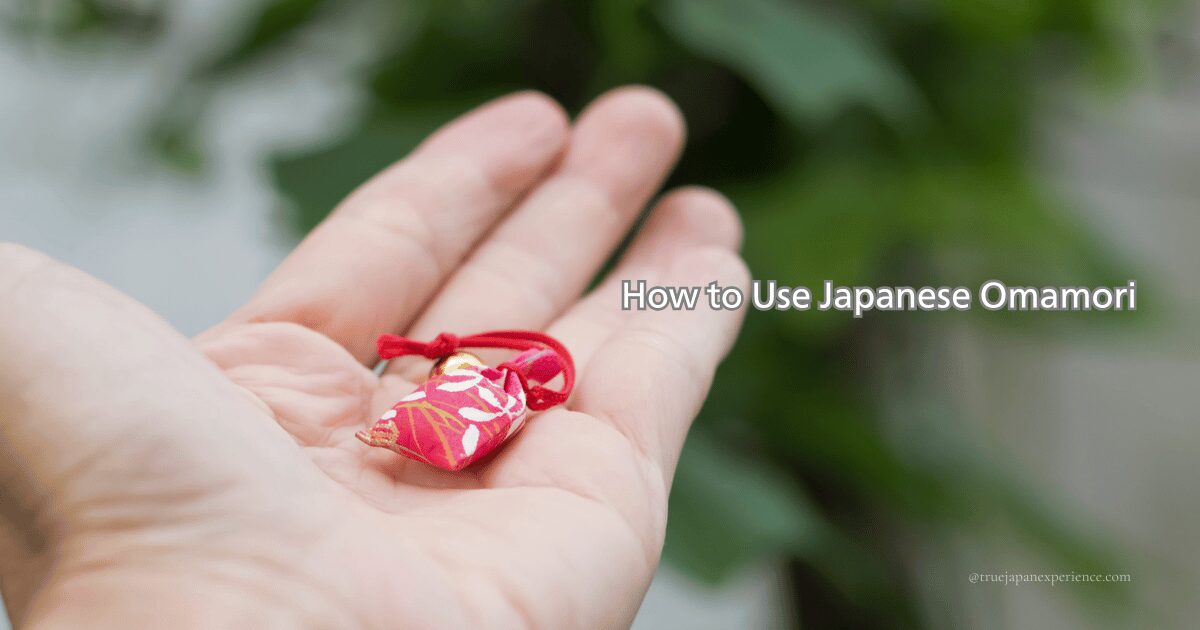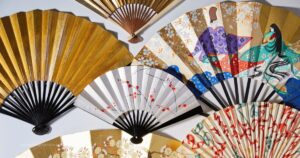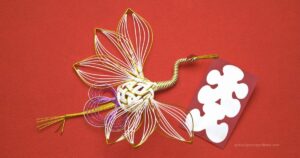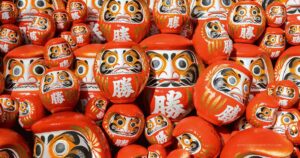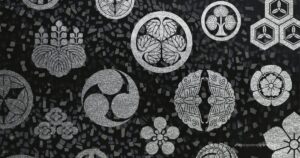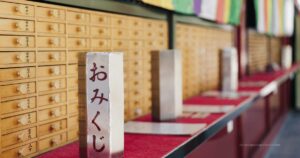Many travelers are curious about how to use omamori, the colorful charms found at shrines and temples across Japan.
These small items are more than just souvenirs — they carry wishes for love, health, success, and protection.
In this guide, you’ll learn what omamori are, how to use them, and why they’re important.
What Is an Omamori?
Omamori are small, colorful charms that you can receive at Japanese shrines or temples.
Omamori come in many shapes and materials. Some are soft cloth bags with blessings inside, while others are made of wood, paper, or even metal. People carry them to wish for good luck, health, love, safety, or success.
The word “omamori” comes from the verb mamoru, which means “to protect.”
These charms are spiritual items, not just souvenirs. By keeping one close, you are believed to receive protection from bad luck or evil spirits.
Many omamori are shaped like small cloth bags tied with a string at the top.
These bags hold a sacred blessing inside, so you should not open them.People believe that opening the bag will weaken its power.
The Origin and History of Omamori
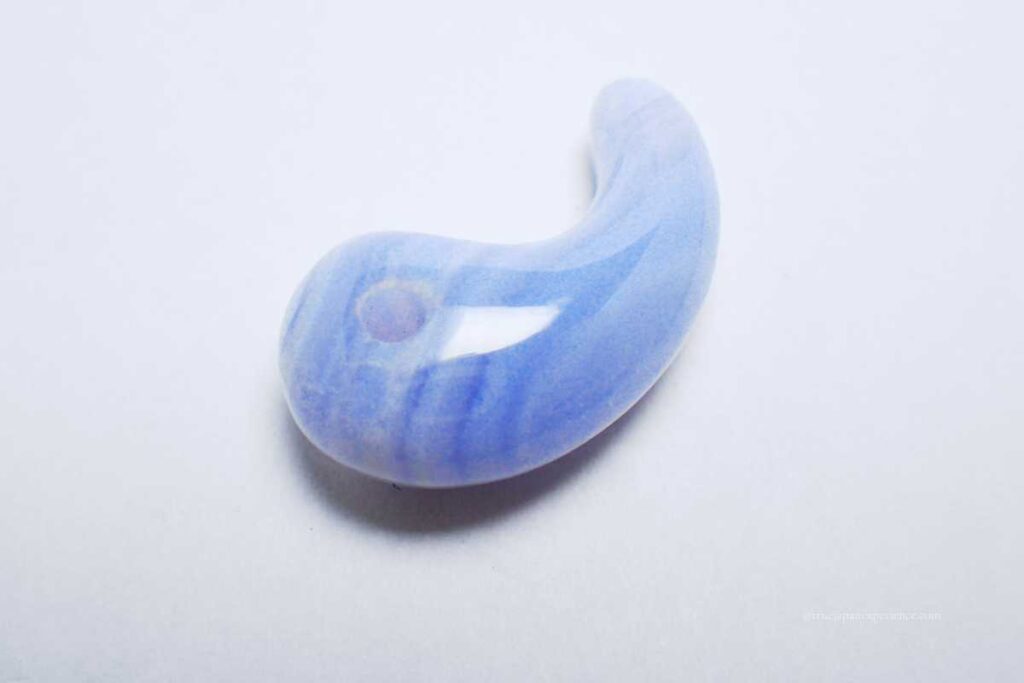
The history of omamori goes back thousands of years.
In the Jomon period, people used magatama (comma-shaped beads) to protect themselves from bad spirits. These were the first lucky charms in Japan.
Later, in the 6th century, as Buddhism came to Japan, temples started to give out protective papers called “ofuda”.
In the Heian period, nobles and warriors carried charms into battle or kept them at home for their family’s safety.
By the Edo period, omamori became common among ordinary people. They were used for health, safety, success, and peace at home.
Today, they are an important part of Japanese life and are loved by tourists from around the world.
How to Use Omamori
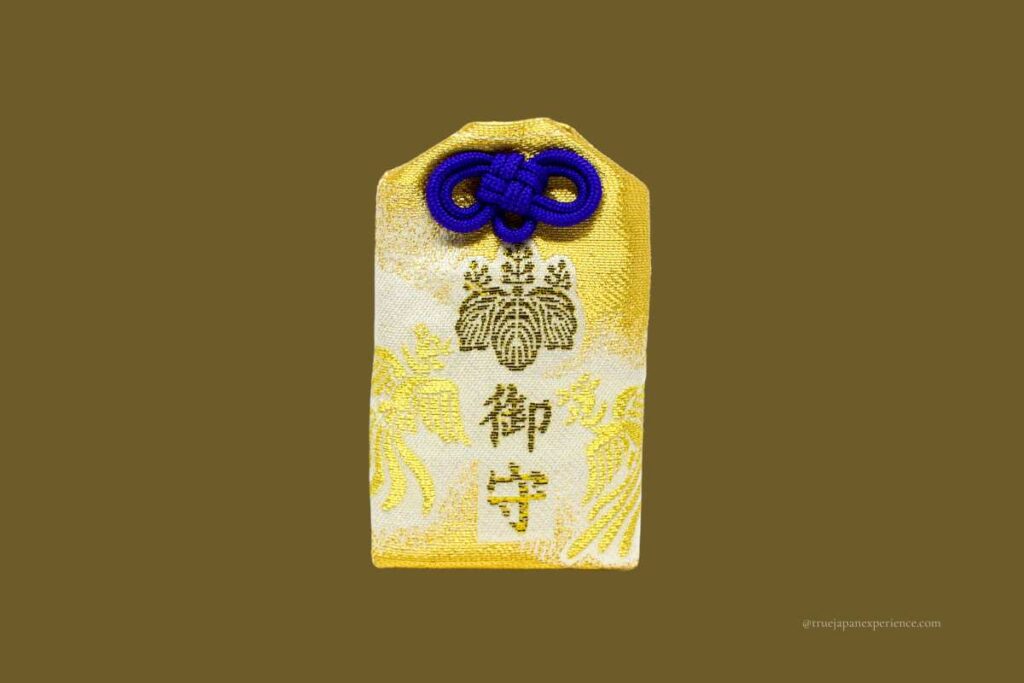
Many travelers wonder how to use these charms correctly.
After receiving one, they often ask:
“Where should I keep it?” “Can I open it?” “Is it okay to carry more than one?”
Let’s take a look at some basic tips first. You’ll find more details in later sections.
・Choose one that matches your wish (love, health, success, etc.)
・Keep it close — in your bag, wallet, or car
・Do not open it — the prayer inside should remain sealed
・Treat it with respect — it’s a sacred item
Many people replace their omamori once a year, often at New Year or after a big event.
But there is no strict rule — you can keep it longer if you still feel connected to it.
It’s not about religion — it’s about hope and protection.
What’s Inside an Omamori?
Many people wonder what’s really inside an omamori.
Here are some examples of what might be inside:
・A paper or wooden charm with the name of the deity or prayer
・Sacred words or symbols
・A small item like a stone, bell, or coin (for energy or good fortune)
These items are blessed by the shrine or temple.
People believe that opening the bag will weaken its power. It may also break the charm, so it’s better not to look inside.
Even if you open it by mistake, don’t worry — just handle it with care and respect.
Types of Omamori and Their Meanings
Omamori come in many types, and each one has a special meaning.
Some are for health, others for love, success, travel, or protection. Each one carries a prayer, and you can choose based on the wish that is most important to you.
Let’s take a closer look at the most common types of omamori and what they mean.
Health Omamori
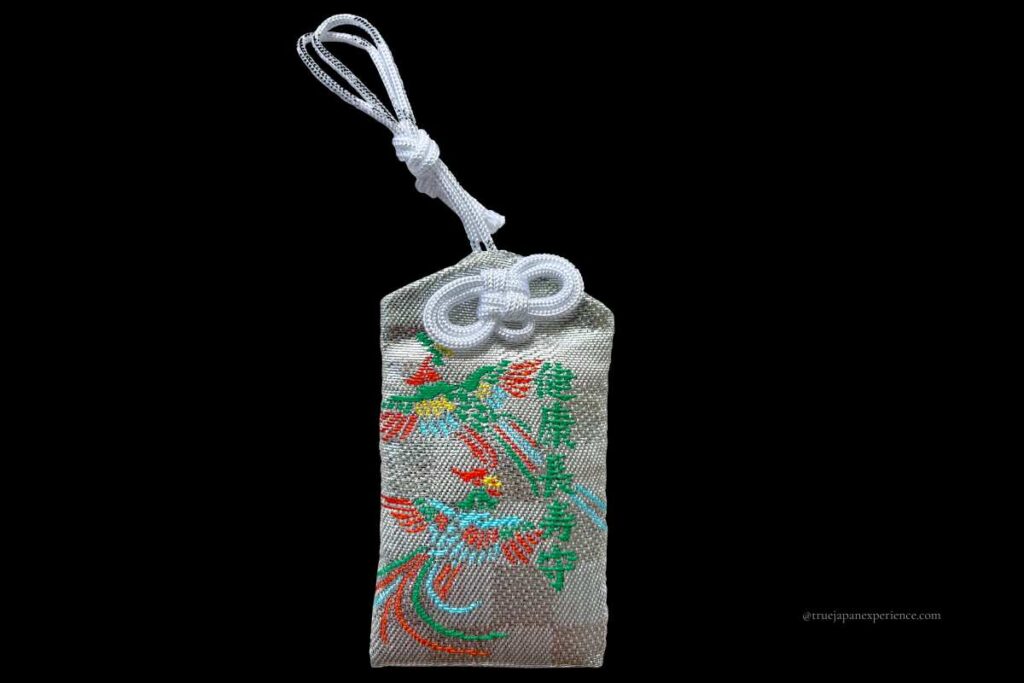
A health and longevity omamori, designed with elegant birds that symbolize well-being and protection in Japanese culture.
Health omamori are popular for people who want to stay strong or recover from illness.
You can receive them at both shrines and temples.
At temples, they are often connected to Yakushi Nyorai (the Medicine Buddha) or Amida Nyorai (the Buddha of Light and Life).
Safety Omamori
These include traffic safety, home safety, and even airplane safety.
They are perfect for drivers, commuters, or travelers.
Carrying one can give peace of mind during your daily life or journey.
Love and Relationship Omamori

These charms help with romance, finding a partner, or keeping a happy marriage.
Some shrines also offer “good match” omamori, which bring new relationships or friendships.
Couples can get “meoto mamori” (husband and wife charms) to stay strong together.
Success and Study Omamori
Great for students, job seekers, or anyone with goals.
Study omamori help with exams and learning, while career omamori support promotions and victories in life.
They are popular during entrance exam season in Japan.
Wealth and Business Omamori
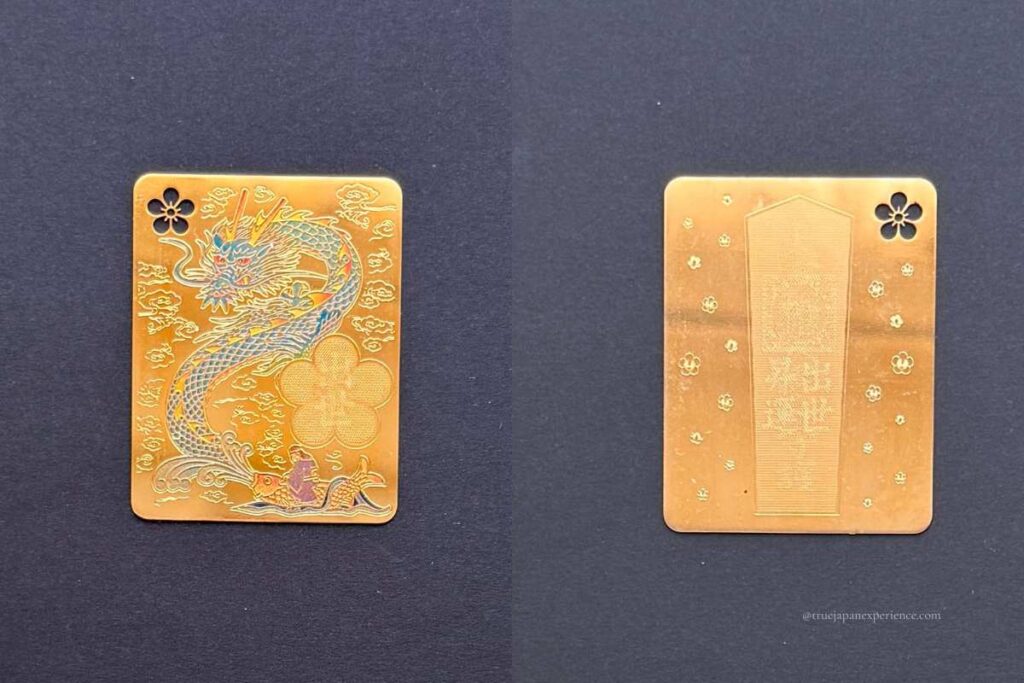
This unique gold omamori from Dazaifu Tenmangu Shrine features a powerful dragon and is believed to bring success, promotion, and good fortune.
These omamori support financial success, business growth, and good luck with money.
They are often found at shrines dedicated to Ebisu (god of business).
Some also include lucky items like gold symbols or coins.
Child and Safe Birth Omamori
These protect mothers and children.
They include charms for having a baby, for a safe pregnancy, or for children’s safety.
You can find safe childbirth omamori at many shrines and temples across Japan.Some places are especially famous for these blessings and are visited by many people before birth.
Protection and Evil Removal Omamori
These charms help keep bad spirits and bad luck away.
They often use bells or symbols for spiritual power.
They are perfect when you feel uncertain or are entering a new phase of life.
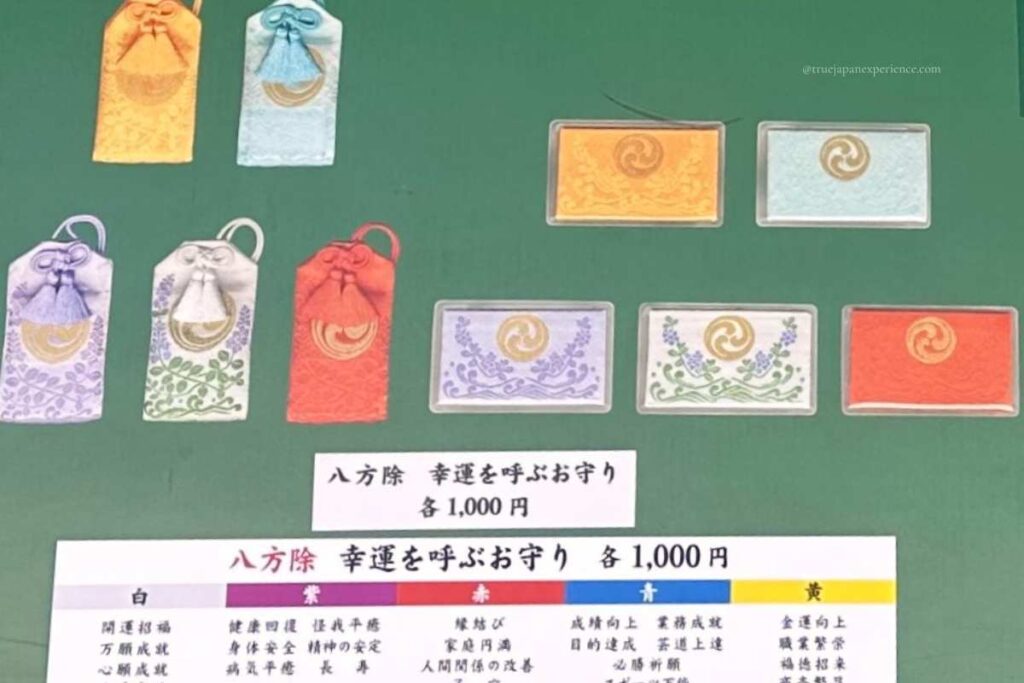
Omamori from Samukawa Shrine, each color offering a different type of blessing — from health and safety to prosperity and love.
Shrine vs. Temple Omamori
Omamori come from both Shinto shrines and Buddhist temples.
Here are the key differences:
| Shrine Omamori | Temple Omamori | |
|---|---|---|
| Religion | Shinto (many gods) | Buddhism (Buddhas and Bodhisattvas) |
| Focus | Love, traffic safety, childbirth | Health, protection, family peace |
| Design | Shinto symbols | Buddhist patterns |
| Inner Blessing | Kami (god) protection | Buddha’s spiritual power |
It’s fine to carry both types together. Japan respects many beliefs side by side.
Where and How to Receive an Omamori
You can receive an omamori at a special counter inside the shrine or temple grounds.
If you’re not sure which omamori to get, it’s okay to ask the staff.
You can tell them what kind of wish you have — like love, health, or safety — and they will show you some options.
In Japan, people don’t say they “buy” an omamori — they say they “receive” or “are granted” one.
This is because omamori are considered sacred, not just souvenirs.
When you visit a shrine or temple, think of it as receiving a blessing, not making a purchase.
Recently, many famous shrines offer online omamori with international shipping. However, visiting in person and praying is always a deeper experience.
Giving Omamori as a Gift: What to Know
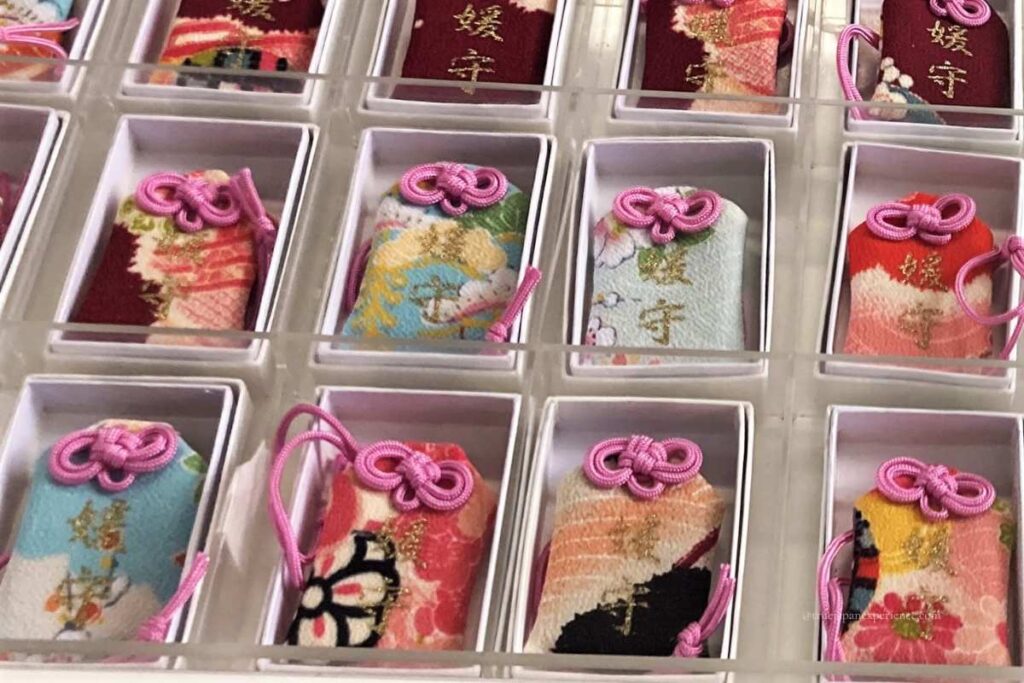
These “Hime-mamori” charms from Aioi-sha at Shimogamo Shrine are designed to support women’s hopes and protection. Each one features a different kimono fabric pattern — no two are the same.
You can give omamori to someone you care about — a friend, a family member, or even a co-worker. It’s a simple and thoughtful way to say, “I’m wishing you good luck.”
When choosing an omamori as a gift, think about the person’s situation.
For example, you might choose a success omamori for a student, or a love omamori for someone who hopes to find a good partner. There are many types, so you can find one that fits their needs.
Also, remember that some people have strong feelings about religion or spiritual items. If you’re not sure, it’s okay to ask before giving one. Being respectful shows kindness.
Even a small effort can show your heart.
And think about the timing, too — like before an exam, a big trip, or a new job.
A well-chosen omamori can be a meaningful gift, filled with hope and good wishes.
Can You Carry More Than One Omamori?
Yes! It’s okay to carry several omamori.
Many Japanese people do it. There’s no rule against it.
Just make sure:
・Each omamori is for a different purpose
・You treat each one with the same respect
・You don’t carry them roughly or forget about them
You are not collecting points — you are holding wishes.
Be thankful for each one.
When to Return or Replace Omamori
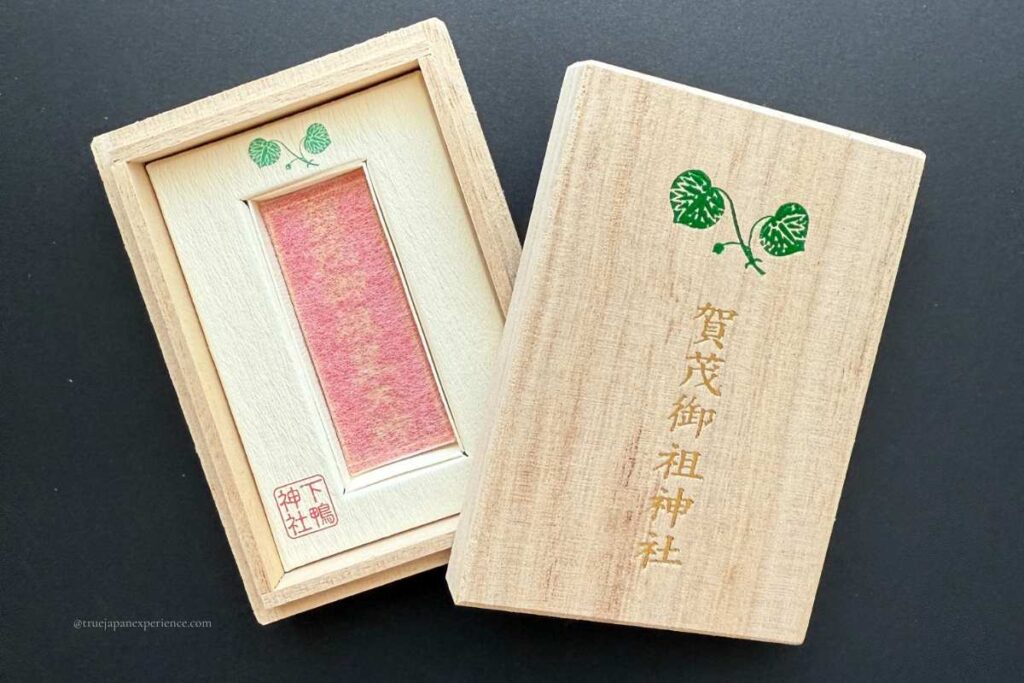
Kamisugi-mamori is a sacred charm from Shimogamo Shrine, made with cedar bark from the shrine’s sacred tree. It’s carefully placed in a wooden box and known for offering deep spiritual protection.
There is no official expiration date for omamori.
But in Japan, many people return them after one year. This comes from the custom of thanking the gods or Buddhas once a year and receiving a new charm for fresh protection.
You can also return an omamori when your wish has come true, or when you feel its role is complete.
It’s okay to keep one longer, especially if it has special meaning to you.
Even if more than a year has passed, what matters most is how you treat it.
Most shrines and temples have a return box for old omamori.
People often place the charm there with a short prayer of thanks. Some also offer a small coin to show gratitude.
If you live far away, you can send it back by mail.
But please never throw it in the trash — omamori are sacred items and should be treated with respect.
If You Can’t Return Your Omamori
If you cannot return your omamori to a shrine or temple, don’t worry.
It’s still possible to take care of it at home with respect.
One simple way is to wrap the omamori in clean white paper.
Before that, you can sprinkle a little salt over it to purify it — once on the left, once on the right, and once again on the left.
Then, say a short thank-you in your heart and place it in the trash, separately from other waste.
This is not the perfect way, but it is acceptable if done with care and good feelings.
However, if you ever have the chance, returning the omamori to a shrine or temple is always the best and most respectful option.
Final Thoughts
Omamori are more than good-luck charms. They carry prayers, wishes, and centuries of tradition.
Now you know how omamori work, what’s inside, and how to treat them with care.
Ready to visit a shrine and receive your omamori?
Check out our Shrines & Temples Guide to plan your visit.
